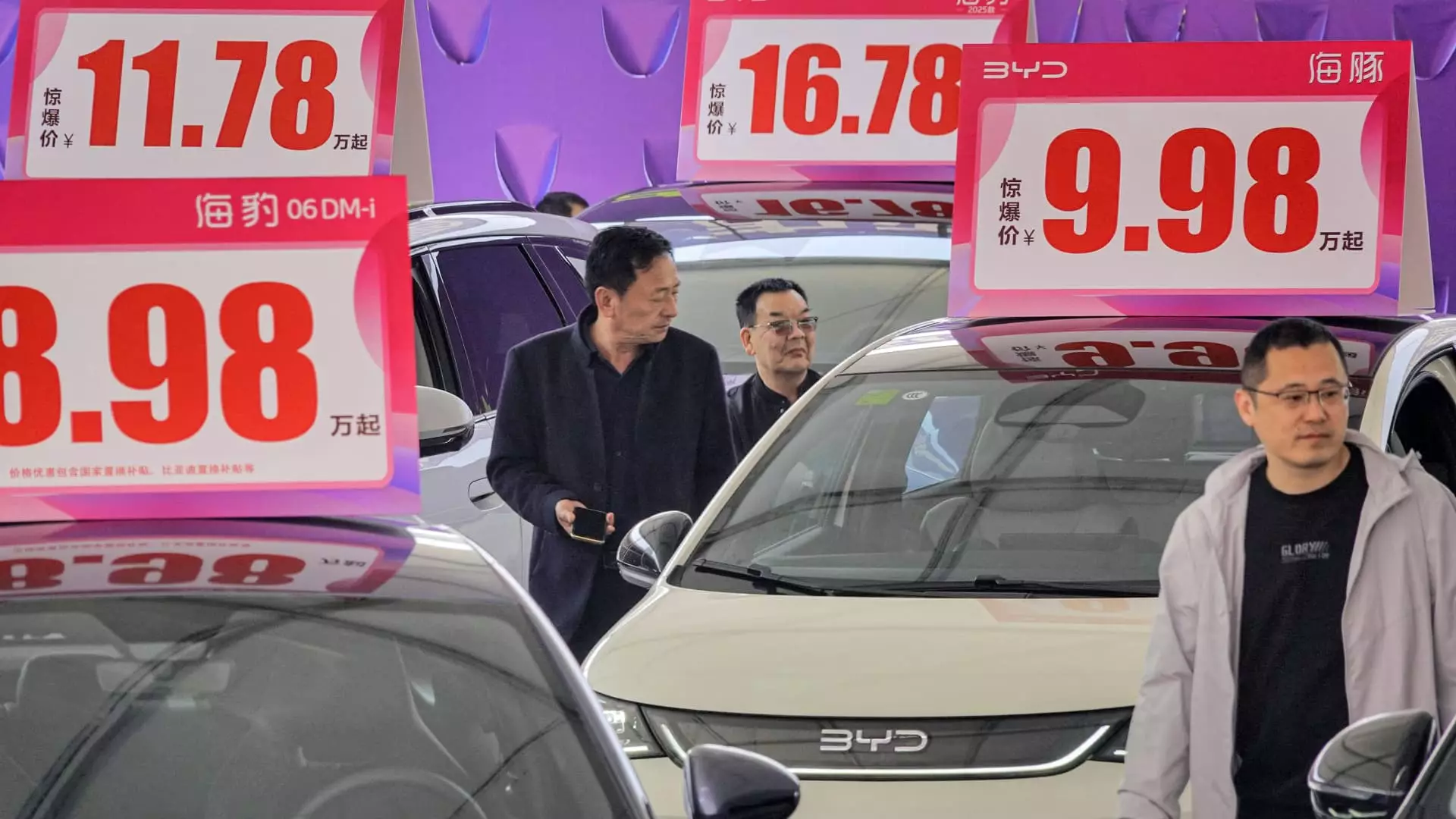China’s electric vehicle (EV) market has propelled itself into a chaotic arena, where survival seems at odds with stability. Recently, automotive behemoth BYD slashed the prices of its cars—some cutting nearly 30% off their original prices—creating a seismic shift in how the domestic market operates. Sudden price drops, such as the Seagull compact car now costing just 55,800 yuan (approximately $7,750), have sent shockwaves through an industry already teetering on the edge of fiscal ruin. The immediate aftermath of these drastic cuts raises a pressing question: what does this imply for smaller manufacturers struggling to carve out their foothold in a tumultuous landscape?
BYD’s price slashing isn’t merely a competitive strategy; it feels more like a desperate gamble. Analysts have noted that the entire industry feels under threat from these aggressive pricing strategies, which could drive weaker companies into obscurity or bankruptcy. As noted by Zhong Shi of the China Automobile Dealers Association, the industry’s nerves are frayed, and competition has morphed from a friendly rivalry into a psychological battleground. There’s no longer room for complacency as the market reacts to BYD’s move, spurring other auto manufacturers to follow suit, lest they fall behind into irrelevance.
Supply-Demand Imbalances and Their Implications
The plight of the electric car market remains tightly interwoven with China’s overarching economic malaise, characterized by sluggish growth and a lack of consumer demand. Morgan Stanley’s Chief China Economist Robin Xing aptly highlighted this troublesome dynamic, asserting that the ongoing price competition indicates persistent imbalances between supply and demand—an imbalance that perpetuates deflation rather than encouraging consumption.
Despite pressure from policymakers to stimulate consumer spending, the prevailing models continue to favor supply-driven strategies rather than crafting sustainable demand. The economic implications cannot be understated; when businesses prioritize pricing over genuine consumer engagement, they risk inflicting long-term damage to their brand value. The repercussions could even extend beyond borders, as this focus on cutting costs to boost sales might encourage a race to the bottom that undermines quality and innovation.
The Parallels to Past Crises
Making parallels to prior crises in Chinese economic history can offer further insight into the situation at hand. Wei Jianjun, Chairman of Great Wall Motors, likened the electric vehicle surge to China’s real estate bubble, hinting at an inevitable crash if caution isn’t exercised. When the real estate sector fell apart due to excessive debt and identical desperation for growth, the landscape became littered with companies unable to survive the fallout.
If the automotive industry mirrors this trend, it could lead to daunting outcomes—mass layoffs, instability, and a reduction in national economic strength, especially when economies worldwide are already grappling with inflation and recession fears. The specter of another “Evergrande” event in the auto sector looms threateningly, emphasizing the urgency of addressing these imbalances before they spiral out of control.
A Diversified Approach: The Key to Survival
While price-cutting remains a popular tactic, one may wonder if it is indeed a sustainable route forward. Industry experts argue that automakers must instead employ a diversified range of strategies—integrating new technology and enhancing user experiences—rather than focusing solely on pricing. Free features such as advanced driver-assist systems have become a valuable tactic for brands aiming to entice the consumer without going down the self-destructive path of endless price wars.
In March, Geely-backed Zeekr announced plans to roll out their advanced driver-assist for free, directly contesting unconventional methods of price manipulation and setting a standard for other manufacturers. By expanding offerings and improving their value propositions, these companies could forge deeper connections with potential customers. It’s time for the industry to abandon the notion that price is the only determinant of consumer choice.
International Ramifications and Geopolitical Strategies
The effects of China’s aggressive push into the EV market are not confined within its borders. As Chinese manufacturers seek to expand into international markets, the ramifications reverberate globally, drawing retaliatory measures such as increased tariffs from the EU and the United States. The world is watching closely as these nations react to what they perceive as unfair advantages courtesy of government subsidies supporting the EV sector.
As competition intensifies and protectionist measures multiply, there’s a deeper ideological battle at play—one that intertwines economic strategy with national sovereignty. Countries protect their markets not only out of self-interest but also from a burgeoning fear of dependency on Chinese manufacturing, an outcome that could upset geopolitical balances. The stakes have never been higher; the outcome of this race could render long-lasting shifts in the auto industry and the global economic landscape.
The turbulence within China’s electric car market is indicative of a broader narrative encapsulating economic instability that must be addressed with both creativity and caution. As prices drop and competition escalates, the industry stands at a crossroads—either embrace an enlightened approach or continue spiraling downward into a realm of chaos.


Leave a Reply